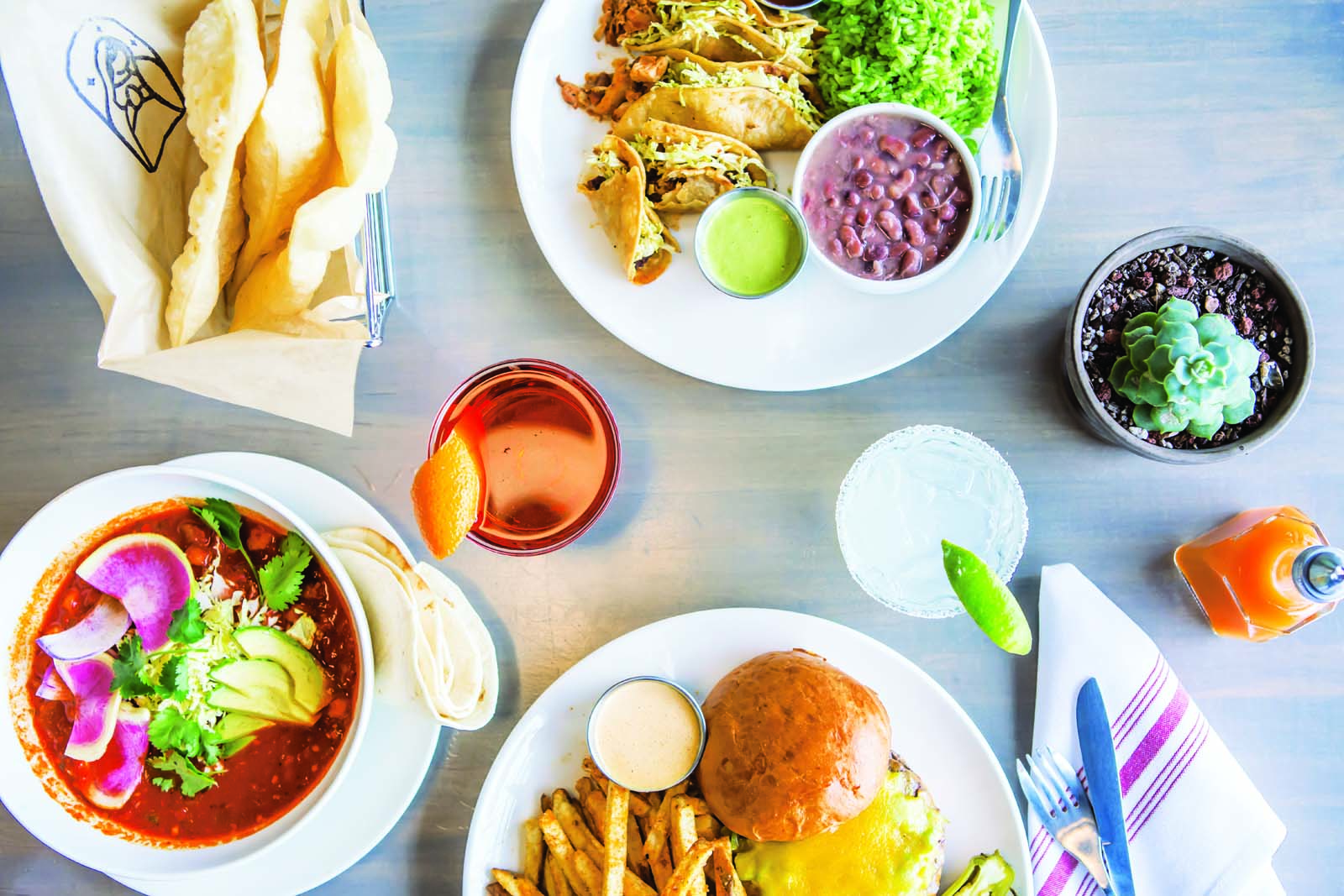The Local newsletter is your free, daily guide to life in Colorado. For locals, by locals.
Santo
2 Stars
- The Draw:
- The chile and masa nuances of New Mexican cooking in a comfortable urban space with cheerful service
- The Drawback:
- Menu wanders into international territory at the cost of real focus
- Don’t Miss:
- Sopaipillas, posole, fried tacos, green chile burger, ice creams, barrel-aged cocktails
One sign of a booming restaurant ecosystem is, à la Charles Darwin, specialization. First come the Thai joints; later, Northern Thai; then, the tangy fermented sausages of Isan. First Spanish tapas; then, the small plates of Catalonia, called “pintxos.” We’re seeing more of that sort of culinary evolution on the Front Range recently, and the opening of Santo in Boulder late last year is one example. Taos-born chef Hosea Rosenberg—who, with head butcher Nate Singer, has turned Blackbelly and its meat shop into an important locus of the butcher’s art—created Santo as an homage to the cooking of Northern New Mexico.
Defining that cooking is complicated. It all begins, of course, farther south. The great, varied cuisine of Mexico presides over a vast transnational region, with local tastes and ingredients inflecting dishes whose origin stories lie well in the past. Back on American soil, New Mexican cuisine has a reputation for being less gloppy and supersized than your archetypal Tex-Mex combo plate; it’s more about the clear flavors of a few specific ingredients. For example, Hatch chile terroir and the effects of sun-drying on red iterations are serious business in the pepper-mad state.
I am not an expert on New Mexican cuisine, so I got in touch with Santa Fe’s Cheryl Alters Jamison, the author and winner of multiple James Beard Foundation awards who co-wrote Tasting New Mexico. First, she told me, look for the ancient Pueblo crops at the heart of that cuisine: corn, beans, and squash. After that, viva los chiles. “The chile sauces are truly prominent in main dishes, a real slathering. Whether red or green, the sauces should be made almost purely of chile. No cumin—that’s Tex-Mex. No tomato—that’s AZ-Mex.” She also said the most important meat preparation is “carne adovada,” or pork slow-cooked in red chile. Finally, a plea: “Don’t forget the sopaipillas, our big floofy fried breads, which are a side dish, not a dessert.”

Rosenberg did not forget the sopaipillas, and the bar at Santo, which dominates the middle of this compact restaurant like a village plaza, is the place to perch and eat them. They arrive in a stainless steel basket with two little squeeze bears of different wildflower honeys. Santo’s sopaipillas are indeed floofy, crisp yet tender, and hot as the dickens—all of which makes them not unlike the best fried state fair thing ever. They play well alongside a warming bowl of posole, which at Santo is a light, two-part desert harmony of earthy red and green Hatch chiles and hominy. But they also make a fine snack with something effervescent from the concise drink list—which includes a tap pouring beer from the Land of Enchantment’s La Cumbre Brewing Co., cans from Sante Fe Brewing Company, and Gruet bubbly from Albuquerque. Or go for Santo’s barrel-aged boulevardier, spiked with tequila and chile- and coffee-infused bitters; of the five drinks I sampled, it was the most concentrated and focused.
Many other New Mexican touch points dot Santo’s menu. You can get carne adovada as a side dish or heaped on Navajo fry bread (which are sopaipillas, more or less) with beans and slaw and more red chiles, a nacholike pileup. Green chile graces rellenos and enchiladas and is also slathered on the juicy smashed Santo burger (which, Rosenberg says, is an homage to a New Mexico chain called Blake’s Lotaburger). When the weather was cooler, there was a three-squash soup with butternut, acorn, and kabocha, and similar squashes are sometimes offered, roasted in the wood oven, as a side. There are fresh masa harina sopes and blue corn tortillas (blue corn being an old Pueblo crop). A legume purist at our table enjoyed a side of perfectly creamy-starchy pinto beans.
The restaurant does a marvelous job with fried tacos as well—crunchy corn tortillas pursed around succulent, spicy bison tongue, with cilantro crema and an earthy “salsa seco,” or dried red chile sauce, for dipping. (The invention of crispy fried tacos may rest with a pioneering New Mexican food writer named Fabiola Cabeza de Baca Gilbert, who published a recipe in the 1930s, two decades before the launch of Taco Bell.) And when I had them, those sopes—like tortillas, but thicker and chewier—came with beans, radish, Cotija cheese, a red pepper jelly reminiscent of tamarind, and duck confit.
Wait. Duck confit?
Rosenberg’s tribute to New Mexico, it turns out, is also about riffing, producing a local mouse/global mouse tension on the fancier edges of the menu. A roast duck entrée in the winter lineup, for example, featured “wood oven baby root vegetables, farro, Brussels sprouts, and pomegranate.” What was the trendy grain of the ancient Etruscans doing at this party? A wagyu skirt steak came topped with porcini butter. Braised lamb neck was paired with carrot purée and cumin yogurt, sounding more Beirut than Taos.
Before even sampling those dishes, I was vaguely disappointed. This sort of global wandering is so common on American menus, even as it muddies up regional exploration. Why not hominy, instead of farro, with that duck? Quinoa pops up in one salad; why not something crunchy out of corn? This isn’t to say that Rosenberg doesn’t try: A salad of Little Gem lettuce had both a creamy corn vinaigrette with a nice tart kick and a ring of modernist, freeze-dried corn powder (the same stuff, I believe, that makes Blackbelly’s corn cookies so addictive).

But Rosenberg could go a lot further into New Mexican food before hauling out the likes of that porcini butter (no longer on the menu), which was chalky and did not do much for the perfectly cooked wagyu. And there were other basic execution faults in the four meals I ate at Santo. The duck was flabby (although better on a second order). Wood-fired vegetables lacked wood-fire scorch. A couple of sides were over-salted while others were greasy.
For dessert, there was a pine nut tartlet with a blue corn crust, cinnamon cream, and chokecherry syrup that sounded promising, but the crust was claylike, the cream was whipped halfway to butter, and the syrup lacked the tannic counterpunch the sweet dish needed. Ice creams by Denver’s Ice Cream Alchemy were much better: a tequila version, tinged with orange, was like a creamsicle dipped in the good stuff, while another iteration was fragrant, but not hot, with green chile.
All that said, my most recent meal at Santo was by far the best. We had the sopaipillas and tacos, plus a salad of cactus and citrus that was bright and crunchy, and the boulevardier. We arrived just after nine, as the place was winding down, but were made welcome. Service, as it had been before, was friendly in a bro-ish bar-and-bistro way. The room is a pleasant, modern space that signals New Mexico with tilework, carved wooden saints (“santos”) tucked into arched wall insets, and a few cacti and photos but avoids Santa Fe clichés.
My wish for this cheerful, perpetually busy restaurant is that Rosenberg, one of Boulder’s more talented and less fussy chefs, pulls more deeply from his roots, taking up the cause of defining modern New Mexican food. Viva los chiles—and hold the farro.









